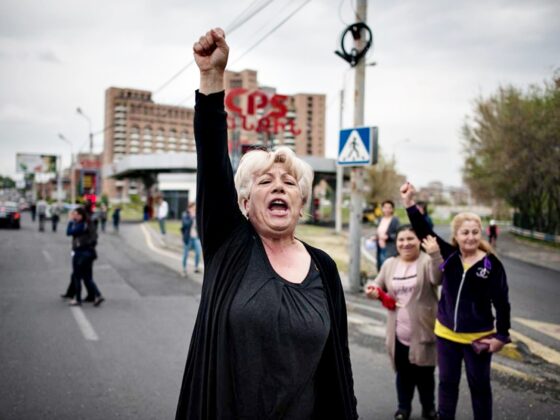(PONARS Policy Memo) Donald Trump’s triumph in the 2016 presidential election discharged an unprecedented political and media movement linking his victory to Russian interference in the U.S. political system. The president’s defenders called this a “witch hunt” but they frequently became cornered by the significant amount of U.S. public and Congressional opinion that wanted Washington to curtail any possible amelioration in Russian-U.S. relations. Just recently, for example, the Democratic Party filed a lawsuit against Trump, Russia, and WikiLeaks for allegedly conspiring in the 2016 campaign.
There are two major explanations for this anti-Russia movement. The first is that Americans were shocked to discover that the U.S. political system can be vulnerable to foreign interference. This led to coordinated attempts to fix election-related security holes, with one of these being, in the eyes of many, the president himself and his administration. The second explanation sees that regardless of what Russia did in the 2016 election, the anti-Russia movement is essentially an anti-Trump campaign. This explanation involves the use of a “foreign threat” narrative as a tool to limit the political capacity of an unpopular president. Examining the history of U.S.-Russian relations from a “constructivist” perspective substantiates this second explanation over the first, with the implication that U.S.-Russian relations fell further victim to U.S. domestic politics. My hypothesis is not aimed to counter the assessments of U.S. intelligence experts on Russia’s “meddling” but rather to deconstruct the reasons for the public’s intense reaction to the situation.
Suspicions and Accusations
Wikipedia now has an entry titled “Timeline of Russian interference in the 2016 United States elections” that lists a multitude of events directly or indirectly linked to the alleged Russian interference. Among the major accusations is a U.S. Department of Homeland Security report that says Russian hackers penetrated U.S. voter-registration systems and were responsible for the DNC email leaks. There is also the joint claim by the FBI, CIA, and NSA that states: “President Vladimir Putin ordered an influence campaign in 2016 aimed at the U.S. presidential election. Russia’s goals were to undermine public faith in the U.S. democratic process, denigrate Secretary Clinton, and harm her electability and potential presidency.” The claim continues: “We further assess Putin and the Russian Government developed a clear preference for President-elect Trump.” This line echoes Hillary Clinton, who during the third presidential debate on October 19, 2016, blamed Russia for the DNC email leaks and accused Trump of being a “puppet” of Putin. Public interest began to focus on any possible links between Trump’s team and Russian citizens, with suspicions being cast, for example, on meetings between Trump’s associates and Russian Ambassador Sergey Kislyak. At the peak of the movement (which has ongoing peaks), some journalists and politicians discussed whether Trump was an actual Russian agent.
The official investigations into the matter are ongoing. They have already produced some proof of Russian meddling and a list of suspects involved. However, the nature of parts of the investigations, gravity of charges, and sufficiency of evidence is heavily linked to party affiliations. A segment of the American public tends to believe intelligence agency claims that Russia meddled, influenced the election results, and there was probable collusion between Trump’s team and Moscow’s officials. Another segment tends to downplay the significance of Russia’s interference and reject any hint of collusion. For example, in March 2018, House Republicans “prematurely closed” their Trump-Russia probe without interviewing key witnesses such as Michael Flynn, Paul Manafort, and Rick Gates. Because hard facts are hard to come by, I suggest looking at several examples from the past to better understand the current U.S. domestic perceptions.
Russia as a Traditional “Constitutive Other” of the United States
The core of constructivism, a prominent theory of international relations, is the notion that any given society needs an external peer, a “Constitutive Other,” in its domestic struggle for self-identification. This foreign nation becomes an indispensable part of domestic political identity discourses. Often, and for different purposes, this Other is portrayed as a model, threat, or pupil. For more than a century, Russia and the United States were “Constitutive Others” of each other.
The first known debate in the United States that directly involved Russia took place in 1813 when critics of President James Madison, who signed the U.S. declaration of war against England, framed their anti-war demonstrations as banquets to celebrate the Russian victories over Napoleon.[1] This led politicians and pundits from multiple U.S. political camps at the time to immerse themselves in a debate about the “real values” of Russia. Those who organized the banquets praised Russia for being Europe’s liberator from Napoleonic tyranny, while others demonized Russia as a barbaric country whose victories should not be celebrated. Their discussions were not really about the merits of Russia—Americans in 1813 had very little interest in the distant Russian empire—rather they were a vehicle through which to discuss the policies of the Madison administration. These debates laid the foundation for U.S. domestic discussions about Russia.
Later, the Bolshevik revolution triggered the first U.S. “Red Scare” in the United States. The rise of Communism during and after World War II generated the second Red Scare. During the second one, a fake pamphlet was widely circulated titled “Communist Rules for Revolution” that listed threats to the American way of life. The pamphlet was first published in 1946 and widely circulated at the peak of McCarthyism when Florida Chief Attorney George Brautigam declared that it was a genuine document. This pamphlet’s short list of “rules” created huge conspiracy theories. It had points such as: “Corrupt the young, get them away from religion. Get them interested in sex. Make them superficial. Destroy their ruggedness” and “Cause the registration of all firearms on some pretext, with a view to confiscating them and leaving the populace helpless.” During this time, everything that American conservatives considered dangerous was ascribed to communist influences (the pamphlet probably originated from a conservative flank of U.S. society). Even though The New York Times published an article in 1970 proving the pamphlet was not authentic, many members of Congress continued to receive copies of it from alarmed constituents and it was even inserted into the Congressional Record. Of note, during the perestroika era, Russian conservatives produced their own variant of a demonic Western plot against Russia called the “Dulles plan.”
The Cold War was a period when deep ideological differences between the United States and the USSR acquired the dimension of state-to-state competition. From the late 1940s to the late 1980s, the repertoire of mutual demonization became enriched and propagandized by both countries. However, the two superpowers avoided direct collisions, thus the Cold War can be considered more as a discursive phenomenon than a direct military confrontation. Battles were waged by proxies in Vietnam, Afghanistan, and elsewhere, but they did not alter bilateral relations (the Vietnam War even overlapped with the détente era). The 1990s seemingly put an end to the Cold War’s narratives, but the rhetorical repertoire of describing the Other as “the enemy to blame” was only on standby.
In 2011-2012, a new freezing rain began in the bilateral U.S.-Russian relationship (on top of domestic cracks appearing in both countries). In Russia, a wave of anti-government protests reactivated the Kremlin’s struggle to identify an enemy. The Russian government needed to alienate anti-regime groups and individuals, and did so by portraying them as Washington’s pawns. The rhetoric demonized the United States for meddling in Russian politics, for planning regime change, and for using oppositionists as puppets.
On the U.S. side, Russia, too, again became a point of contention. For instance in 2012, Republican presidential nominee Mitt Romney told voters that Russia was America’s number one geopolitical foe. He was not trying to degrade Russia per se, but rather undermine and cast doubt on his rival’s policies, namely President Barack Obama’s “reset” with Moscow. Romney’s aim was to cut down Obama’s foreign policy achievements by playing on the shadows of U.S. anti-Russian stigmas.
From late 2016, this narrative format—a familiar scenario of linking political opponents to a foreign country while simultaneously demonizing that country—came back into play. Trump’s victory caught Americans, especially the U.S. establishment and the Democratic Party electorate, as a surprise. His very appearance, his biography, and his beliefs looked so alien to the American political elite and much of the public that their immediate temptation was to call him “un-American.” In the Cold War years, “un-American” was partially synonymous with being “Russian” or “communist.” To many anti-Trumpers, including U.S. propagandists, he was seen as “Russia’s president,” a “Russian implant,” and “Putin’s puppet.” During the Women’s Marches the day after Trump’s inauguration on January 21, many posters and slogans satirized old-fashioned masculinity and depicted Trump as a sinister stooge of Putin (see the PONARS Eurasia blog post with images). The broader scenario was a habitual cultural turn that uses a foreign Other as a scapegoat for domestic disorder. The Trump election was a critical juncture in U.S. history when American identity was put into question. Who are Americans? Are we liberal democrats or, as Clinton said about Trump’s base, a “basket of deplorables?”
The Consequences for Russian-U.S. Relations
It is not clear what the final outcomes of the current “Russiagate” in domestic U.S. politics will be. What is obvious is that the anti-Russian mania adds to the disruption of U.S.–Russian relations. In the short-term, public and elite biases will not permit Trump to make any moves that improve U.S.–Russian relations or negotiate any compromise with Russia on pressing issues. The medium- and long-term consequences may include the further demonization of Russia as threatening to the U.S. political system, sentiments of vulnerability and weakness of U.S. democracy vis-à-vis an authoritarian challenger, and the refusal to understand Russia’s concerns even when they are legitimate. The image of Russia as a threat will probably hinder the future of bilateral relations long after Trump and Putin are out of office, the same way as Cold War ghosts have appeared over the past decade in the public debates and political speeches in both Washington and Moscow.
One important result of the escalated tensions between Russia and the United States is the further weakening of the position of Russia’s liberals. Historically, the periods of U.S.–Russian cooperation were also times of domestic liberalization in Russia, while periods of hostility coincided with the Kremlin’s clampdown on liberal elements in society. The ongoing “Russiagate” in the United States helps the Russian government label its opponents as pro-American figures working for the interests of a threatening foreign power. By excessively paralleling the comportment of the Trump and Putin regimes and by replicating Russia’s obsession over its “Constitutive Other,” the United States is not helping all those in Russia who see the West and democracy as a model to emulate.
Ivan Kurilla is Professor at the European University at St. Petersburg.
[PDF]
[1] U.S. politicians opposed to U.S. involvement in the War of 1812 deridingly called it “Mr. Madison’s war.” Technically, the Americans who fought against Great Britain were on the same side as Napoleonic France.
Homepage image credit










